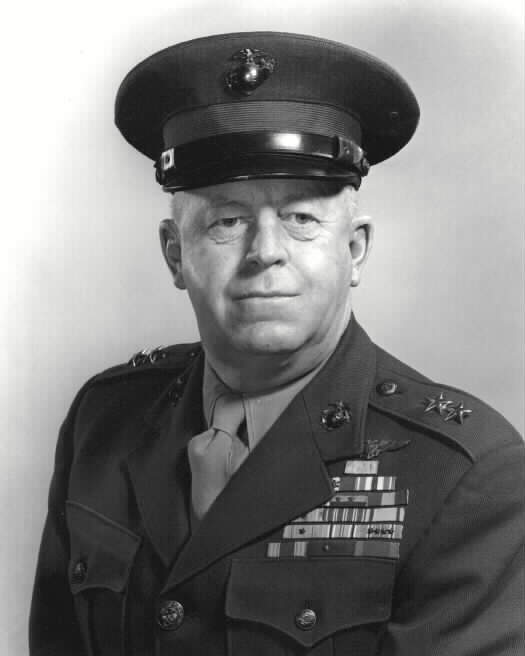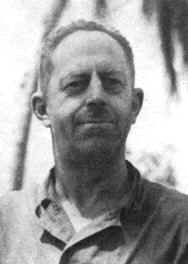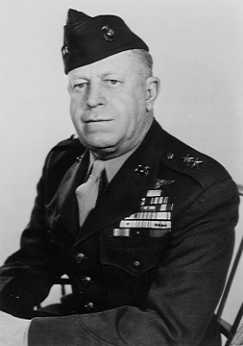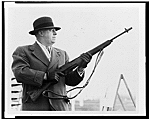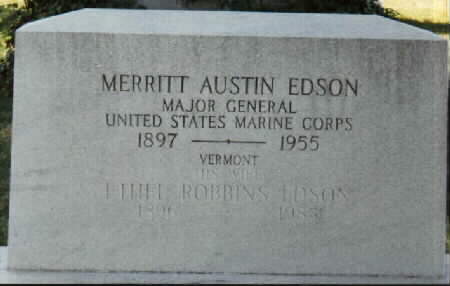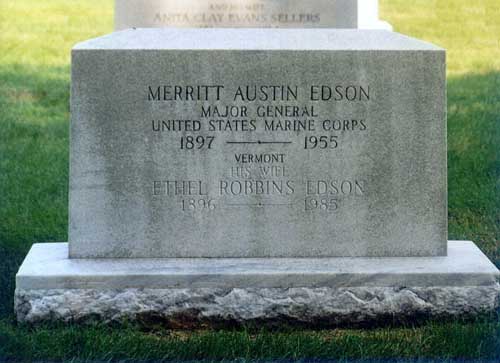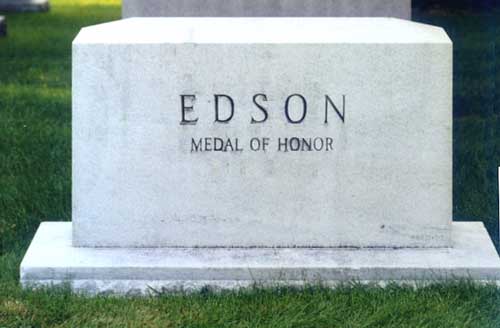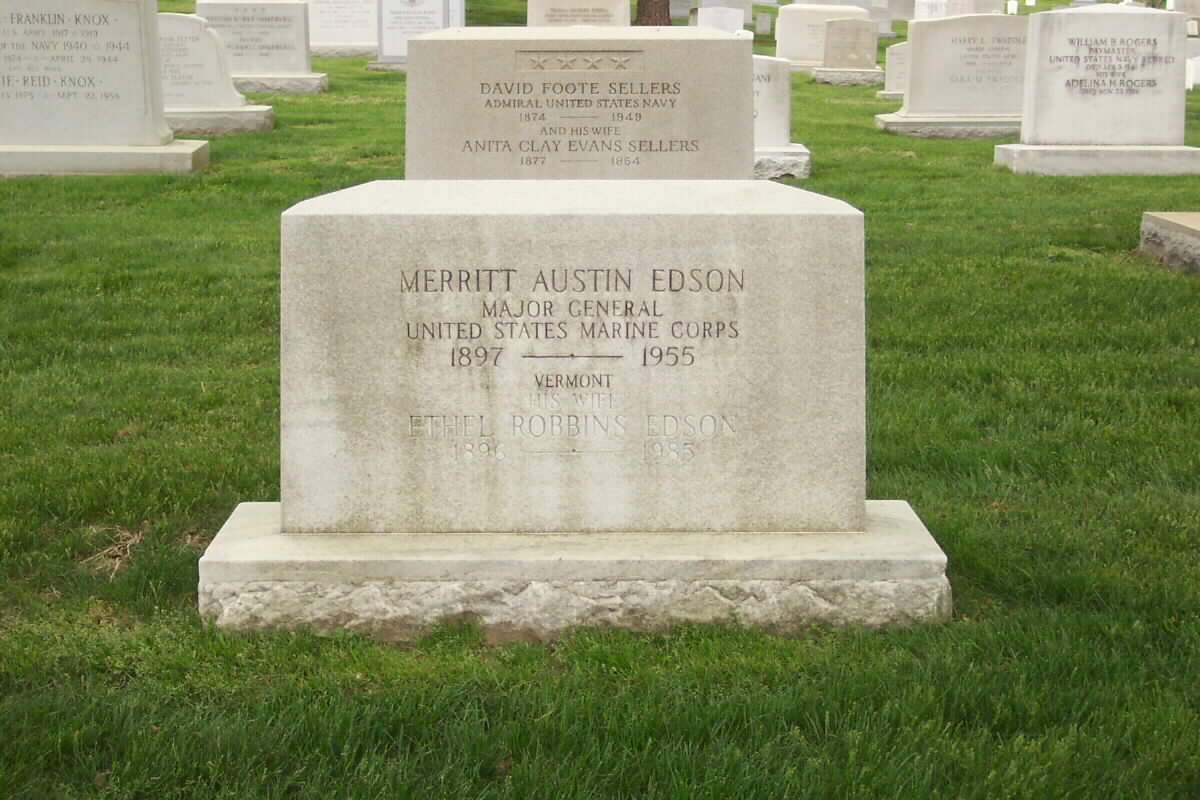Courtesy of the United States Marine Corps:
Major General Merritt Austin Edson, known as “Red Mike” of the U.S. Marines, retired from active duty on 1 August 1947 and died on 14 August 1955, in Washington, D.C. He completed more than 30 years in the military service of his country.
Born in Rutland, Vermont, on 25 April 1897, and reared in Chester, Vermont, Edson attended the University of Vermont for two years. Military service interrupted, however, and on 27 June 1916 Edson, as a private, First Vermont National Guard Regiment, was sent to Eagle Pass, Texas, for duty on the Mexican border. He returned to the University in September 1916, but joined the Marine Corps Reserve on 26 June the following year.
Thus began a career which was to be characterized by its diversity and distinguished even by the high standards of the Marine Corps. He was commissioned a second lieutenant in the Regular Marine Corps on 9 October 1917. In September of the next year he sailed for France with the 11th Marines. This regiment saw no combat, but during the last six months of his European tour, Edson commanded Company D, 15th Separate Marine Battalion, which had been organized for the express purpose of assisting in the holding of a plebiscite in Schleswig-Holstein, Germany. Owing to the failure of the United States to ratify the Treaty of Versailles, this mission, however, was never carried out.
Following the end of World War I, Edson began a diversified series of assignments that were to qualify him for the high commands he was to hold in later years. As a first lieutenant, he spent the two years at Marine Barracks, Quantico, Virginia, as the Adjutant-Registrar of the fledgling Marine Corps Institute. His efforts greatly contributed to the organization and establishment of this “University for Marines.” This was followed by a short tour in Louisiana guarding the mails.
His interest in military aviation then prompted him to apply for flight training at Pensacola, Florida. He won his gold wings in 1922. Soon after, he was ordered to the Marine Air Station at Guam. Here he had his introduction to the semitropical islands of the Marianas with which his name was later to become so closely linked.
Upon his return to the United States in 1925, Edson first took an extensive course in advanced aviation tactics at Kelly Field, Texas, and then attended the Company Officers’ Course at Quantico, Virginia. He was graduated with the highest grades ever attained by any student up to that time. For physical reasons, however, Edson had to give up his flying status in 1927 and revert to ground. He was then assigned to duty as Ordnance Officer at the Philadelphia Navy Yard.
Late in the same year, he was ordered to sea duty as Commanding Officer of the Marine Detachment on the USS Denver. During her service in Central American waters, Captain Edson’s detachment was ashore in Nicaragua during the period February 1928 to 1929. In command of 160 picked and specially trained Marines, he fought twelve separate engagements with the Sandino-led bandits and denied them the use of the Poteca and Coco River valleys. Here he received his first Navy Cross for actions in which “his exhibition of coolness, intrepidity, and dash so inspired his men that superior forces of bandits were driven from their prepared positions and severe losses inflicted upon them.” From a grateful Nicaraguan government, Captain Edson was also awarded the Nicaraguan Medal of Merit with Silver Star.
In September 1929, Captain Edson returned to the United States and was assigned as tactics instructor to fledgling Marine lieutenants at the Basic School in Philadelphia. Upon detachment from that duty he became Ordnance and War Plans Officer at the Philadelphia Depot of Supplies for the next four years.
This ordnance duty was not new to Edson who was closely associated with the development of small arms marksmanship within the Marine Corps. In 1921, he had been a firing member of the winning Marine Corps Team at the national matches at Camp Perry, Ohio. In 1927, 1930, and 1931, he served with the rifle and pistol teams as assistant coach. During the regional matches of 1932 and 1933, he acted as team coach and captain, respectively. Upon the resumption of the national matches in 1935, he was captain of the Marine Corps national rifle and pistol teams of 1935 and 1936, winning the national trophies in both years.
After short tours at Parris Island and Marine Corps Headquarters in Washington, D.C., he was enrolled in the Senior Officers’ Course at the Marine Corps Schools, Quantico, Virginia, in 1936.
Foreign duty as operations officer with the 4th Marines in Shanghai, China, from 1937 to 1939, enabled Edson to observe closely Japanese military operations. The knowledge thus gained stood him in good stead during the Pacific war.
His second tour of duty at Marine Corps Headquarters began in May 1939 when, as Inspector of Target Practice, he was in a position to stress the importance of every Marine being highly skilled with his own individual arm.
In June 1941, he as again transferred to Quantico, to command the 1st Battalion, 5th Marines, which was redesignated the 1st Separate Battalion in January 1942. The training exercises which he conducted in the succeeding months with Navy high speed transports (APD’s) led to the organization of the 1st Marine Raider Battalion in early 1942. This unit was the prototype of every Marine Raider Battalion formed throughout the war.
Colonel Edson’s introduction to the Pacific theater of operations began with the overseas training of his raider command in American Samoa. On 7 August 1942, the Free World was thrilled by the news that his raiders, together with the 2d Battalion, 5th Marines, had landed on Tulagi, British Solomon Islands. Two days of severe fighting secured this strategic island. This action was followed by raids on Savo Island and at Tasimboko, on Guadalcanal. Colonel Edson was awarded a Gold Star in lieu of a second Navy Cross for his successful conduct of the Tulagi operation.
His crowning glory and the battle for which he will be long rememberd by Marines and a grateful American people was the defense of Lunga Ridge on Guadalcanal on the night of 13-14 September 1942. His Raider Battalion, with two companies of the 1st Parachute Battalion attached, had been sent to a ridge line a short distance south of Henderson Field. Here they were supposed to get a short rest. When the Japanese forces unexpectedly and viciously attacked the position on the first evening, they penetrated the left center of Edson’s line of resistance, thus forcing a withdrawal to a reserve position.
Here approximately 800 Marines withstood the repeated assaults of more than 2,500 Japanese on the “Bloody Ridge,” as it became known to the world. To the men of the 1st Raider Battalion, however, who sustained 256 casualties, it became “Edson’s Ridge,” in high honor of the officer who “was all over the place, encouraging, cajoling, and correcting as he continually exposed himself to enemy fire.” His nickname, “Red Mike,” originating from his red beard worn in Nicaragua days, was also his code name during this battle. From then on Edson was known by all as “Red Mike.”
The citation for the Medal of Honor he received for this action read in part as follows:
Facing a formidable Jap attack which had crashed through our front lines, he successfully withdrew his forward units to a reserve line with minimum casualties.
When then the enemy, in a subsequent series of violent assaults engaged our force, Colonel Edson, although continuously exposed to hostile fire throughout the night, personally directed defense of the reserve position against a fanatical foe of greatly superior numbers.
By his astute leadership and gallant devotion to duty, he enabled his men, despite severe losses, to cling tenaciously to their position on the vital ridge, thereby retaining command, not only of the Guadalcanal airfield, but also of the First Division’s entire offensive installations in the surrounding area.
A brother officer said of him shortly thereafter that officers and men would willingly follow him anywhere-the only problem was to keep up with him. A combat correspondent testified that “he is not a fierce Marine. In fact he appears almost shy. Yet Colonel Edson is probably among the five finest combat commanders in all the United States armed forces.”
It was also said that he was not readily given to a show of emotion. Nevertheless, when his personal runner of several months service was killed at the second battle of the Matanikau River on Guadalcanal, witnesses said he “cried like a baby,” and later stated that he man could never be replaced.
In August 1943, he was named Chief of Staff of the 2d Marine Division, which was then preparing for Tarawa. He prepared an estimate of the situation for this operation which proved to be surprisingly accurate and has since become a classic in Marine Corps military literature. For this action he received the Legion of Merit and was promoted to brigadier general. Later, he was appointed Assistant Division Commander of the 2d Division and participated in this capacity in the capture of Saipan and Tinian. The Silver Star was awarded him for these operations.
Edson became Chief of Staff, Fleet Marine Force, Pacific, in October 1944, and for his services during the ensuing year was awarded a Gold Star in lieu of a second Legion of Merit. Duty as Commanding General, Service Command, Fleet Marine Force, Pacific, rounded out 44 months of continuous service in the war zone. When a young officer once asked Edson when he might expect to be rotated back to the United States, Edson replied, “When the war’s over; when the job’s done.”
In December 1945, he was assigned to the Office of the Chief of Naval Operations and, in February 1947, to Marine Corps Headquarters. Retirement from active duty came at the age of 50 years, at which time he was promoted to major general.
In addition to the Medal of Honor, two Navy Crosses, a Silver Star and two Legions of Merit, his numerous decorations included the Presidential Unit Citation with two bronze stars; the Mexican Service Medal; World War I Victory Medal with Maltese Cross; Second Nicaraguan Campaign Medal; China Service Medal with bronze star; American Defense Service Medal with bronze star; American Campaign Medal; Asiatic-Pacific Campaign Medal with six bronze stars; the World War II Victory Medal; the Distinguished Service Order (British Empire) and the Nicaraguan Medal of Merit.
Following his retirement, General Edson’s civilian service was equally distinguished. He became the first Commissioner of the Vermont State Police, organizing the force partially from an older organization of motor vehicle officers. He set up an efficient organization on a semi-military basis. This system which has since been adopted by other states.
Returning to Washington, D.C., in July 1951, General Edson became Executive Director of the National Rifle Association. His major efforts in that post were directed in stimulating the interest of Americans in rifle marksmanship. Concurrently, he campaigned vigorously for a Marine Corps, adequate both in size and strength for its many commitments.
At the time of his death, in addition to his duties at the Rifle Association, he was the Navy representative on the Defense Advisory Committee on Prisoner of War Problems. This group formulated recommended standards of conduct for American prisoners of war. These were later adopted and promulgated as the Code of Conduct for all American servicemen.
To those who knew him personally, Edson will be best remembered for his keen professionalism, his magnificent personal leadership in battle, and his sympathetic understanding of the soul of a Marine.
USMC Photo
Born on April 25, 1897, he was a career Marine officer who was know in the Corps as “Red Mike,” as a result of his exploits in the Pacific Theater of Operations during World War II. He took part in operations on Guadalcanal (where he earned the Medal of Honor), and in Saipan and Tinian campaigns. Upon his retirement he worked as Director of the Vermont State Police and as Executive Director of the National Rifle Association.
He committed suicide in the garage next to his Washington, D.C. home on August 14, 1955, while serving in the NRA post. He was buried in Section 2 of Arlington National Cemetery. His wife, Ethel Robbins Edson (1896-1985) is buried with him.
Courtesy of the State of Vermont:
Major General Edson was born in Rutland, Vermont, on April 25, 1897. He received his early education in the Vermont towns of Rutland and Chester.
Physically he was not a big man, but underneath he was as rugged as Vermont granite, as tough and straight as the trees of the Green Mountains, as forthright and demanding as Vermont’s cold and icy winters and as kind and generous as her sunny, pleasant summers.
He started his college career at the University of Vermont in the Fall of 1915, and soon thereafter began his military career by joining a company of the First Vermont Infantry. During the Summer of 1916 he was ordered to Eagle Pass, Texas, for service on the Mexican border. At the end of September his company was relieved, enabling him to continue his college studies.
With the United States’ entry into World War I in 1917 near the end of his sophomore year, he enlisted in the Marine Corps Reserve. Early in July, along with nine hundred other aspirants, he took and passed a competitive examination for a permanent commission in the Corps and was commissioned a Second Lieutenant on October 9, 1917. Though unable to finish college, the University of Vermont later recognized his achievements and awarded him an honorary LL.D. Degree in 1944.
During the remainder of World War I General Edson served with the Eleventh Marines in France, and then with the Fifteenth Separate Battalion during the occupation of Germany.
He returned to the states in late 1919 and in August, 1920, he was married in Burlington, Vermont, to Ethel Winifred Robbins, to whom must go recognition for the important role she played in his life. Shortly after his marriage General Edson was transferred to Pensacola, Florida, and in 1922 he was qualified as a Naval Aviator. Serving in Marine Corps Aviation he saw duty on Guam from 1923 until late 1925, and then at Quantico, Virginia, from 1925 until early 1927.
General Edson was then ordered to sea duty, serving for a brief period on the USS Denver and then on the USS Rochester as Commanding Officer of the embarked Marine detachment. Shortly after reporting aboard the USS Rochester his Detachment of sixty men was ordered ashore in Nicaragua, where it became famous as the Coco River Patrol. This superbly trained and led unit slogged through the unbearably hot and musty jungles developing the tactics enabling it to relentlessly track down insurrectionists. Many of these same tactics became very familiar to Marines during the jungle warfare of World War II. It was for this action and his outstanding heroism under fire during this campaign that General Edson was awarded his first Navy Cross, as well as the Medal of Merit by Nicaragua.
For the next few years, 1929 through 1931, General Edson served as a tactics instructor of newly commissioned Second Lieutenants attending Basic School at Philadelphia, Pennsylvania. Remaining in Philadelphia he then served as Ordnance Officer at the Supply Depot from 1931 until 1935. He was transferred in 1935 to Quantico, Virginia, where he soon reached the height of his illustrious record in competitive rifle and pistol marksmanship, a record which began in 1921 when he became a firing member of the Marine Corps Rifle Team. Having become distinguished in both he was appointed to the distinctive position as Captain of the Marine Corps Rifle and Pistol Team in 1935 and again in 1936.
Then followed several years of duty with the Fourth Marines at Shanghai, China, where General Edson, then a Major, observed and studied firsthand the tactics of the Japanese forces.
Returning to the States in 1939, General Edson, then a Lieutenant Colonel, was assigned duty at Marine Corps Headquarters, Washington D.C. During 1941 he was assigned to Quantico as Commanding Officer of the First Battalion, Fifth Marines, which had been designated for special training in amphibious and “commando” type warfare. Following the attack on Pearl Harbor and the United States entry into World War II, this battalion was redesignated the First Raider Battalion which soon was familiarly known as “Edson’s Raiders.” It was an all-volunteer outfit and General Edson, known more familiarly as “Red Mike” (his code name during World War II) personally supervised all phases of its training. Twenty-mile speed marches were routine and the last mile or two was always “on the double” with “Red Mike” leading. The training of the Raiders included closely coordinated exercises with a division of World War I destroyers which had been converted to fast transports, the Manley, Gregory, Little, Calhoun, McKean and Stringham. Later, in the Solomons campaign, the Raiders and nearly all of these destroyer transports were teamed together in successful combat missions.
Before the Raiders left for Samoa in March, 1942, “Red Mike” called his officers and men together in the mess hall at Quantico. In the men’s presence, he told his officers just what was expected of them as leaders. His thoughts were for the welfare of his men first. The officers were expected to conduct themselves in the same manner. He himself was the best example. A commanding officer in the field could demand and get what comforts there were available in the way of shelter, food and clothing. The only things “Red Mike” demanded were fighting hearts and rigid discipline.
On August 7, 1942, he directed the assault of the Raiders on Tulagi, the first offensive assault against the Japanese in World War II. For three days he led his men in battle against fanatical Japanese in caves and dugouts until the enemy was wiped out and this strategic island, where the Japanese had maintained their headquarters for the Solomon Islands, was secure. For his brilliant and courageous action on Tulagi, General Edson was awarded his second Navy Cross.
Three weeks later the Raiders were transferred to Guadalcanal to aid in its defense. Although his men were living at a bare subsistence level and ammunition was almost as scarce as food, “Red Mike” received permission to seek out and destroy the enemy. The Raiders proceeded to do this in a daring and well executed raid against an estimated one thousand well armed Japanese troops located at the Village of Tasimboko. The enemy forces were completely surprised and driven inland, abandoning their supplies, weapons, food and communications, all of which were destroyed, including a unit of artillery.
Defense of Henderson Field on Guadalcanal at that time consisted of positions on the beaches and both flanks. There was no defense at the rear of the Field where the only clear ground in the tangled, forbidding jungle was a grassy ridge several hundred yards long.
“Red Mike” believed that the Japanese forces dispersed at Tasimboko would attempt to strike the defenseless rear and capture the airfield in a bold stroke. Under the guise of seeking “rest and rehabilitation” for his men, he got the First Marine Division’s permission to occupy the ridge.
Immediately he prepared to defend this position amid much grumbling from his tired men who affectionately nicknamed him “Mad Merritt the Morgue Master” because of his apparent eagerness for action. General Edson’s plan was masterfully conceived. Supplies were so short that there was only a single strand of barbed wire to string in front of the advance positions. General Edson knew his men could not stop the Japanese in overwhelming numbers in a knock-down, drag-out action. Instead, he placed his positions far out on the ridge and designated pre-arranged lines in the rear for their withdrawal. It was sort of a “cushion” defense.
On September 11 and 12 the Japanese both bombed the ridge from high-level bombers and shelled it from cruisers. On the night of the 12th, the advance parties of the enemy struck, driving the Raiders from their advance positions. On the 13th, “Red Mike” organized his lines along the ridge closer to the airfield as planned.
That night at about 1900, the enemy force attacked in fanatical waves. First their numbers were thought to be a battalion or two. Actually it was a brigade without the support of the artillery which “Red Mike” had destroyed at Tasimboko.
The Raiders’ right and left flanks soon folded under heavy enemy pressure. In the dark with practically no communications, General Edson personally reformed his lines on the forward slope of the last high ground protecting Henderson Field. There he knew it was do or die. “Red Mike” walked back and forth on the ridge that night personally rallying his men for combat which was often hand to hand after each attack. Dawn came and the Marines, although 144 men fewer than the 880 which had started the battle, still held that last bit of high ground. The Japanese had been repulsed with appalling casualties. Fifty percent of an estimated 3,450 troops.
“Red Mike,” who had been personally exposed to heavy enemy fire for over ten hours, stood on the ridge that dawn, the sleeves of his shirt in shreds from bullets. Yet he had not been hit.
That ground became known as “Edson’s Ridge” and later as “Bloody Ridge”. The battle was one of the turning points of the war. If the Japanese had regained the airfield and kept it, the battle for Guadalcanal would have been lost and the war would have been delayed for months, possibly years.
For the now-famous action, “Red Mike” was awarded the Medal of Honor for “extraordinary heroism above and beyond the call to duty.” For his exploits on both Tulagi and Guadalcanal he was also decorated with the Distinguished Service Order by Great Britain.
A few days later “Red Mike,” who had been promoted to full Colonel, left the Raiders to take command of the Fifth Marines. He called his men together for a brief farewell to thank them for their magnificent efforts. Dirty, dog-tired Raiders, hardened to war, and to its killings, openly wept.
As Commanding Officer of the Fifth Marines, he again displayed exceptional brilliance and tactical skill by outguessing, outmaneuvering and outfiring the cunning and desperate enemy in the Second and Third Battles of the Matanikau River.
After the First Marine Division had been redeployed to Australia for a retraining and rest period, General Edson was detached and in July, 1943, assigned duty as Chief of Staff, Second Marine Division, then preparing for the Gilberts (Tarawa) operation. His outstanding performance of duty and exemplified skill in battle as Commander of Troops ashore during this operation, earned for him not only his first Legion of Merit, but also a spot promotion to Brigadier General and assignment as Assistant Division Commander of the Second Marine Division. In this capacity he participated in the Saipan-Tinian operations from January through August, 1944. For his outstanding valor and skill in battle during this operation he was awarded the Silver Star.
On leaving the Second Marine Division in late August, 1944, he was assigned duty first as Chief of Staff, Fleet Marine Force, Pacific, and then as Commanding General, Service Command, Fleet Marine Force, Pacific, from July through December, 1945. It was during this year and a half period that he was awarded his second Legion of Merit for his outstanding contributions and leadership.
General Edson served 44 months in the combat zone, more than any other Marine officer. During this period he was awarded the Medal of Honor, one Navy Cross, one Silver Star, two Legion of Merit awards, two Presidential Unit Citations and the Distinguished Service Order of Great Britain.
In 1946, General Edson returned to the States and was assigned duty on the Staff of the Chief of Naval Operations. His battles hardly over in the Pacific, by late 1946, he was engaged in another type of action on Capitol Hill. The Marine Corps had been threatened with near abolishment, its post war role to be only that of a small police force, and the nation threatened as well with a General Staff and “single service” concept alien to the forthright beliefs of the freedom loving Vermonter that General Edson was. Unable to stand idly by and see his ideals smashed, he spearheaded the Marine Corps counterattack to save not only the Corps for its traditional role as a major instrument of national defense, but also the separate service and Joint Chiefs of Staff concept of both the Navy and Marine Corps. He did this job so well that legislation was enacted insuring the future of the Corps as a well-manned amphibious striking force. To him must go credit for fully acquainting Congress with the precarious position which the Marine Corps was then in. Feeling that he was unable to fully participate in this Congressional battle over “unification” while on active duty, he twice submitted his request for retirement. It was finally accepted, taking effect in August, 1947. In so doing he sacrificed what probably would have been many more years of illustrious service in the Marine Corps.
In 1951, General Edson left his beloved state of Vermont for a second time and was back in Washington, D.C. with one of his old loves, the rifle, as Executive Director of the National Rifle Association. Under his expert guidance and aggressive leadership, the Association greatly increased its membership, its activity and its international participation. The National Rifle and Pistol Matches at Camp Perry, Ohio, took on a new and larger meaning and shooters once more took interest in international meets such as the Olympics.
In 1951 and in 1953 General Edson once more participated in Congressional Hearings on defense matters, again influencing their outcome. An indefatigable worker, he was recalled to active duty during the Korean War as a personal representative of the Commandant, United States Marine Corps, conducting an inspection tour of Marine Forces then in the Far East. He also served on active duty during May, June and July of 1955 as a member of the Presidential Commission formed to study and recommend standards of conduct for American prisoners of war.
General Edson was an active participant in many organizations and clubs, giving many of them the benefit of his experience and abilities. Over the years he formed associations with the American Legion, Veterans of Foreign Wars, Disabled American Veterans, Army and Navy Union, National Rifle Association, Patrons of Husbandry, Masons, Alpha Tau Omega, First Marine Division Association (past president), Edson’s Raiders Association (past President, Honorary President), National Skeet Shooting Association, Army and Navy Club, Columbia Country Club, National Press Club, and the University Club.
“Red Mike” had so won the hearts of those who served with him that the Edson’s Raiders Association was formed a few years after World War II. Reunions are held annually at Quantico, Virginia, and even today he is still carried on the roster as Honorary President, his spirit never seeming to leave this band of men fused together by his great leadership.
The General was one of the Marine Corps’ most illustrious officers and leaders of all time. He was an outstanding example of those who, unsung, keep the nation’s ramparts strong in peace, and who are summoned in time of war to rally our forces and defend our liberty at all costs. As a United States Marine Corps officer, gentlemen and patriot, he considered it a privilege and an honor to so serve. He was a man of vision and resourcefulness. He was a man of extreme loyalty to his high ideals and to his country. He was an example of leadership and accomplishment, of courage, forthrightness, loyalty and fighting spirit to every young Marine with whom he came in contact.
GENERAL EDSON BURIED
Military Services Are Held for Medal of Honor Winner
WASHINGTON, August 16, 1955 – The body of Major General Merritt A. Edson, a Marine Corps hero of World War II, was buried in Arlington National Cemetery today after military services at nearby Fort Myer, Virginia.
General Edson was found dead Sunday in a garage adjoining his Washington home. The Deputy Coroner, Richard M. Rosenberg, said death was due to carbon monoxide poisoning from exhaust fumes, but his investigation is not completed.
General Edson won the Medal of Honor for his exploits on Guadalcanal during the Pacific campaign against the Japanese.
Until a short time before his death he was engaged with four other retired generals on a study of a code of conduct for American service men who become prisoners of war.
EDSON RULED A SUICIDE
Coroner Gives Verdict in Case of Retired Marine Hero
WASHINGTON, August 22, 1955 – The deputy coroner returned a suicide verdict today in the death of Marine Major General Merritt A. Edson, Medal of Honor winner and leader of “Edson’s Raiders” in World War II.
General Edson’s body was found in his car inside his closed garage August 14. The 58-year-old retired officer died of carbon monoxide poisoning. He was buried last Tuesday at Arlington National Cemetery.
Members of the family said General Edson had been in good health but had worked hard in helping to prepare the new code of conduct for prisoners of war. He was on the Defense Department committee that drafted the code.
EDSON, MERRITT AUSTIN
(First Award)
Captain, U.S. Marine Corps
2d Marine Brigade (Nicaragua),
Date of Action: August 7, 1928
Citation:
The Navy Cross is presented to Merritt Austin Edson, Captain, U.S. Marine Corps, for extraordinary heroism on 7 August 1928, while in command of a Marine patrol on the Coco River, en route to Poteca. Captain Edson upon encountering a force of bandits entrenched upon both sides of the river, personally led his advance guard against the enemy, engaging in hand-to-hand conflict with them, and by his exhibition of coolness, intrepidity, and dash, so inspired his men that the superior force of bandits were driven from their prepared position, and severe losses inflicted upon them.
EDSON, MERRITT AUSTIN
(Second Award)
Citation:
The President of the United States takes pleasure in presenting a Gold Star in lieu of a Second Award of the Navy Cross to Merritt Austin Edson (0-257), Colonel, U.S. Marine Corps, for extraordinary heroism and devotion to duty while serving as Commanding Officer of the Tulagi Combat Group during the landing assault and seizure of enemy Japanese-held Tulagi Island, British Solomon Islands, 7 to 9 August 1942. In personal command of the FIRST Marine Raider Battalion during the initial operation, Colonel Edson advanced the attack of his Battalion and its supporting units with suck skill, courage and aggressiveness that he was an inspiration to the entire Combat Group and was directly responsible for the capture of Tulagi Island. His gallant conduct throughout this hazardous action was in keeping with the highest traditions of the United States Naval Service.
EDSON, MERRITT AUSTIN
Rank and organization: Colonel, U.S. Marine Corps. Born: 25 April 1897, Rutland, Vt. Appointed from: Vermont. Other Navy awards: Navy Cross with Gold Star, Silver Star Medal, Legion of Merit with Gold Star.
Citation:
For extraordinary heroism and conspicuous intrepidity above and beyond the call of duty as Commanding Officer of the 1st Marine Raider Battalion, with Parachute Battalion attached, during action against enemy Japanese forces in the Solomon Islands on the night of 1314 September 1942. After the airfield on Guadalcanal had been seized from the enemy on 8 August, Col. Edson, with a force of 800 men, was assigned to the occupation and defense of a ridge dominating the jungle on either side of the airport. Facing a formidable Japanese attack which, augmented by infiltration, had crashed through our front lines, he, by skillful handling of his troops, successfully withdrew his forward units to a reserve line with inimum casualties. When the enemy, in a subsequent series of violent assaults, engaged our force in desperate hand-to-hand combat with bayonets, rifles, pistols, grenades, and knives, Col. Edson, although continuously exposed to hostile fire throughout the night, personally directed defense of the reserve position against a fanatical foe of greatly superior numbers. By his astute leadership and gallant devotion to duty, he enabled his men, despite severe losses, to cling tenaciously to their position on the vital ridge, thereby retaining command not only of the Guadalcanal airfield, but also of the 1st Division’s entire offensive installations in the surrounding area.
EDSON, MERRITT
M/GEN USMC
VETERAN SERVICE DATES: Unknown
- DATE OF BIRTH: 04/25/1897
- DATE OF DEATH: 08/14/1955
- DATE OF INTERMENT: 08/16/1955
- BURIED AT: SECTION 2
ARLINGTON NATIONAL CEMETERY
Michael Robert Patterson was born in Arlington and is the son of a former officer of the US Army. So it was no wonder that sooner or later his interests drew him to American history and especially to American military history. Many of his articles can be found on renowned portals like the New York Times, Washingtonpost or Wikipedia.
Reviewed by: Michael Howard

